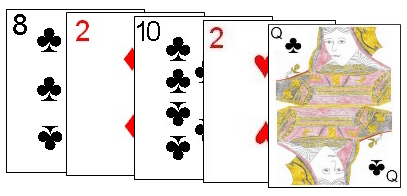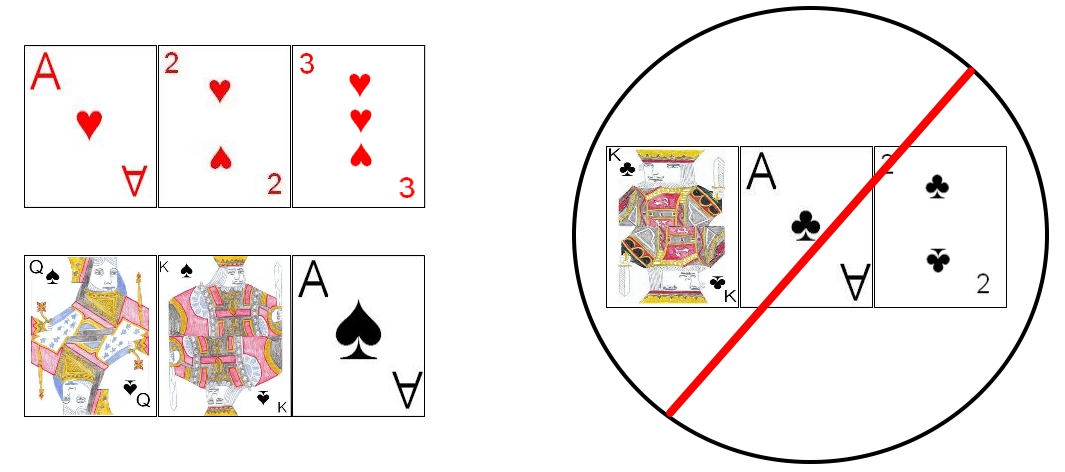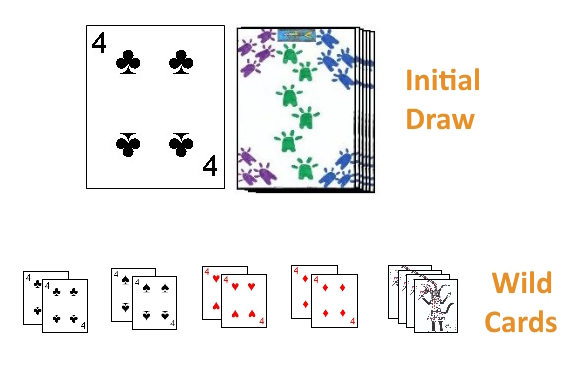
How to Play Crazy Rummy |
 |
| In Crazy Rummy, a meld may contain any number of wild cards. In this example meld, on the first hand of the game, this sequence meld contains two such wild cards. |
| Card Denomination | Point Value |
|---|---|
| Designated Wild Card for that Hand | 25 Each |
| Jack, Queen, King | 10 Each |
| 2, 3, 4, 5, 6, 7, 8, 9, 10 | Value as marked on card |
| Ace | 1 Each |

| Card Denomination | Point Value |
|---|---|
| Designated Wild Card for the Hand | 25 Each |
| King | 13 Each |
| Queen | 12 Each |
| Jack | 11 Each |
| 2, 3, 4, 5, 6, 7, 8, 9, 10 | Value as marked on card |
| Ace | 1 Each |
| Card Denomination | Point Value |
|---|---|
| Beanie Card (Designated Wild Card for that Hand) | 25 Each |
| 9, 10, Jack, Queen, King | 10 Points Each |
| Ace, 2, 3, 4, 5, 6, 7, 8 | 5 Points Each |
 Determination of first dealer and seating positions and first dealer can be performed using any method. Once the first dealer is selected, that player should then thoroughly shuffle the deck and offer it to the player at his left. After the cut, the dealer then begins dealing the cards in a counter-clockwise direction around the table, one at a time and face-down. He continues dealing in this manner until each player has a total of ten cards. He then lays the deck in the center of the table, and removes the top card from the stock and places it face-up, near the stock pile. This card thus determines the rank of the wild cards to be used during the hand. Thus, all the remaining cards of that same rank are considered wild cards (along with the Jokers) on that hand and can thus be used as replacements for any other card in a meld. if the card so turned up is a printed Joker, the dealer places this card randomly back into the middle of the deck and draws another card
to replace it. The player to the immediate right of the dealer has the first turn, and the turns rotate in a counter-clockwise direction around the table.
Determination of first dealer and seating positions and first dealer can be performed using any method. Once the first dealer is selected, that player should then thoroughly shuffle the deck and offer it to the player at his left. After the cut, the dealer then begins dealing the cards in a counter-clockwise direction around the table, one at a time and face-down. He continues dealing in this manner until each player has a total of ten cards. He then lays the deck in the center of the table, and removes the top card from the stock and places it face-up, near the stock pile. This card thus determines the rank of the wild cards to be used during the hand. Thus, all the remaining cards of that same rank are considered wild cards (along with the Jokers) on that hand and can thus be used as replacements for any other card in a meld. if the card so turned up is a printed Joker, the dealer places this card randomly back into the middle of the deck and draws another card
to replace it. The player to the immediate right of the dealer has the first turn, and the turns rotate in a counter-clockwise direction around the table.
| Card Denomination | Point Value |
|---|---|
| Jokers and Wild Cards | 25 Points Each |
| Jack, Queen, King | 10 Points Each |
| 2, 3, 4, 5, 6, 7, 8, 9, 10 | Value as Marked on Card |
| Ace | 1 Point Each |